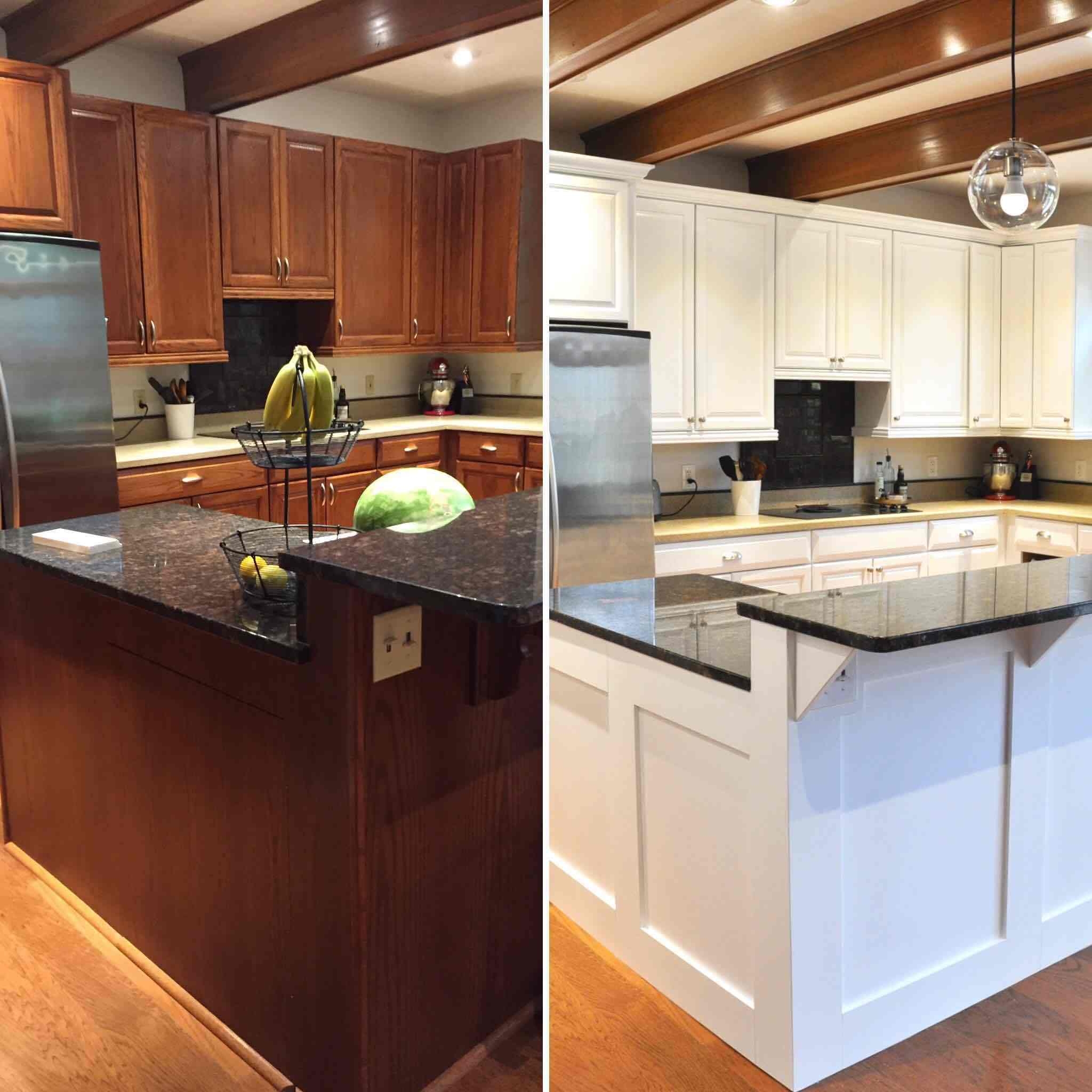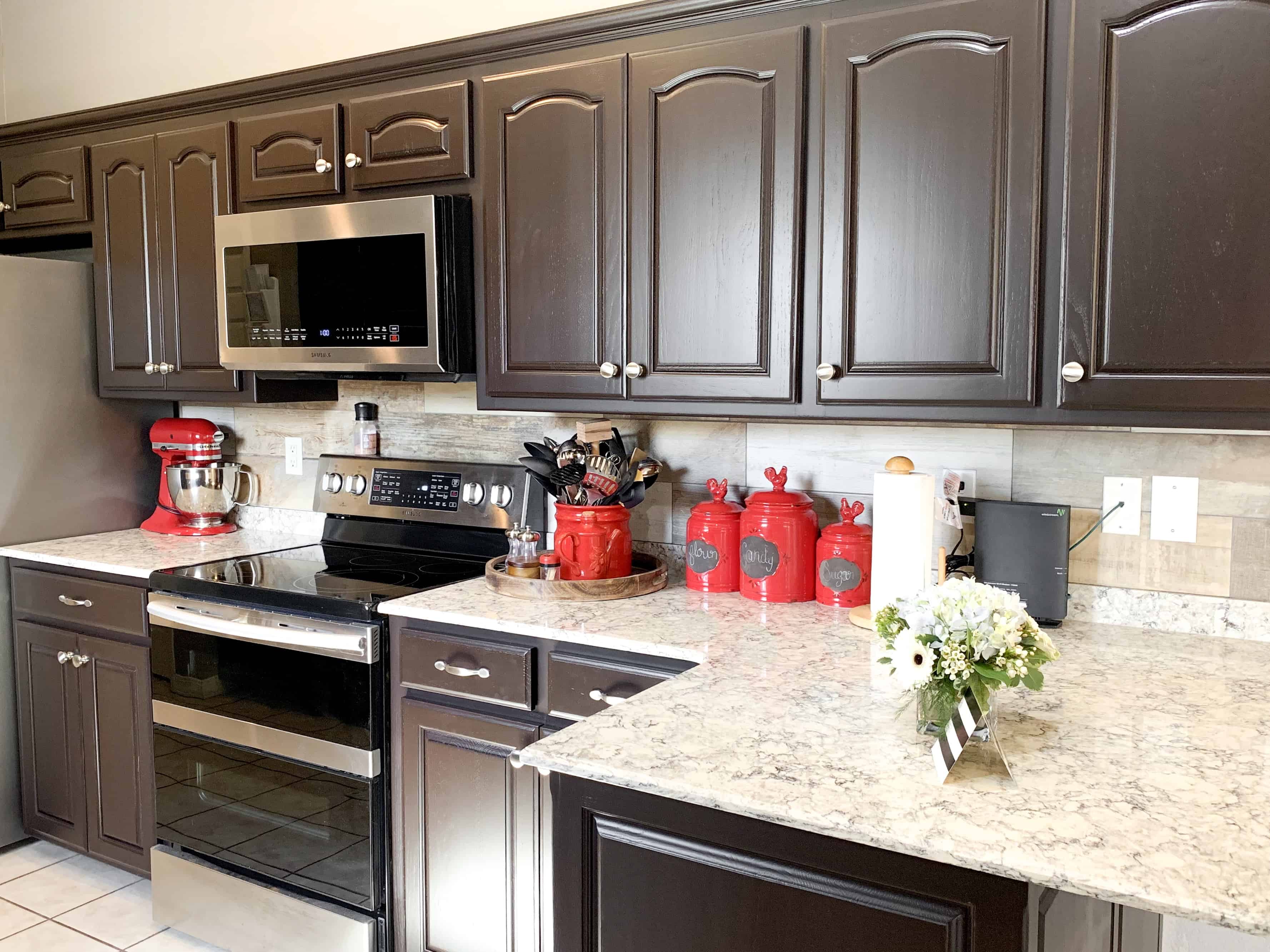Preparing Oak Cabinets for White Paint

Transforming your oak cabinets with a fresh coat of white paint can dramatically brighten your kitchen. However, achieving a professional-looking finish requires meticulous preparation. This section details the crucial steps to ensure your paint adheres properly and lasts for years to come.
Thorough Cleaning of Oak Cabinets
Proper cleaning is paramount before any sanding or priming. Dirt, grease, and old finishes will interfere with paint adhesion, leading to peeling or chipping. The following steps will ensure a clean and receptive surface:
- Remove all hardware: Carefully remove knobs, pulls, and hinges to allow for complete cleaning and painting access.
- Dust the cabinets: Begin by using a tack cloth or soft brush to remove loose dust and debris.
- Wash with a degreaser: Mix a solution of warm water and a mild degreasing dish soap. Use a soft sponge or cloth to gently scrub the cabinet surfaces, paying attention to areas prone to grease buildup.
- Rinse thoroughly: Rinse the cabinets with clean water to remove all traces of soap.
- Dry completely: Allow the cabinets to air dry completely before proceeding to the next step. Avoid using harsh chemicals or abrasive cleaners, which could damage the wood’s finish.
Sanding Oak Cabinets for a Smooth Surface
Sanding creates a smooth surface that improves paint adhesion. Different grits of sandpaper are used for different stages of the process, ensuring optimal results.
| Sanding Method | Grit Level | Purpose | Technique |
|---|---|---|---|
| Initial Sanding | 80-100 grit | Removes old finish and smooths out imperfections. | Use a sanding block for even pressure. Sand with the grain of the wood. |
| Intermediate Sanding | 120-150 grit | Refines the surface, removing scratches from the initial sanding. | Sand with the grain of the wood. Use light pressure. |
| Final Sanding | 220 grit | Creates an ultra-smooth surface for optimal paint adhesion. | Sand with the grain of the wood using very light pressure. |
Filling Imperfections and Wood Knots, How do you paint oak cabinets white
Filling imperfections like knots and dents is essential for a flawless finish. Using a high-quality wood filler ensures these areas are seamlessly integrated into the surface. Choose a wood filler that matches the color of your oak cabinets as closely as possible. Apply the filler according to the manufacturer’s instructions, ensuring it’s level with the surrounding wood. Once dry, sand the filled areas smooth using fine-grit sandpaper (220 grit).
How do you paint oak cabinets white – A close-up image showing the careful application of wood filler to a knot in oak wood, highlighting the smooth finish after drying. The image would showcase the precision of the filler application, demonstrating how the filled area blends seamlessly with the surrounding wood after drying. The texture would appear smooth and even, without any visible imperfections or ridges.
Primer Selection for Oak Cabinets
Primer is crucial for ensuring paint adhesion and longevity, especially on porous surfaces like oak. Different primers offer various benefits.
| Primer Type | Application Method | Drying Time | Cost |
|---|---|---|---|
| Oil-based primer | Brush, roller, or spray | 4-6 hours | Moderate |
| Sheen-based primer | Brush, roller, or spray | 2-4 hours | Moderate |
| Water-based primer | Brush, roller, or spray | 1-2 hours | Moderate to Low |
| Stain-blocking primer | Brush, roller, or spray | 2-4 hours | High |
Painting Oak Cabinets White: How Do You Paint Oak Cabinets White

Painting oak cabinets white can dramatically transform your kitchen or bathroom. The process requires careful preparation, the right paint choice, and meticulous application techniques to achieve a professional, long-lasting finish. This section will guide you through the painting process itself, focusing on paint selection, application methods, and ensuring a smooth, even finish.
Paint Type Comparison for Oak Cabinets
Choosing the right paint is crucial for a successful outcome. Different paint types offer varying properties, impacting durability, ease of application, and final appearance. Consider these factors when selecting your paint.
- Latex Paint: Latex paints are water-based, low-odor, and easy to clean up with soap and water. They offer good durability and are a popular choice for cabinets. However, they may require more coats than oil-based paints to achieve full opacity on dark wood like oak.
- Oil-Based Paint: Oil-based paints offer superior durability and a harder, more resistant finish than latex paints. They tend to level out better, minimizing brushstrokes. However, they have a strong odor, require mineral spirits for cleanup, and take longer to dry.
- Chalk Paint: Chalk paint is known for its matte finish and ease of application. It adheres well to various surfaces, including wood, and often requires less preparation than other paint types. However, it may require a sealant for durability and protection against moisture.
Applying the First Coat of Paint
Applying the first coat correctly sets the stage for the entire project. Different application methods offer unique advantages and disadvantages.
Brush Technique
- Load your brush with a moderate amount of paint, avoiding overloading.
- Apply paint in thin, even strokes, working in the direction of the wood grain.
- Overlap each stroke slightly to ensure even coverage.
- Avoid heavy pressure to prevent brushstrokes from showing.
- Work in small sections to prevent the paint from drying before you can blend it properly.
Roller Technique
- Pour paint into a paint tray.
- Roll the roller in the paint tray to saturate it evenly.
- Apply paint in smooth, even strokes, working in a “W” pattern.
- Roll back and forth over the already painted area to ensure even coverage and minimize streaks.
- Use a smaller roller for detailed areas or corners.
Spray Painting Technique
- Prepare your workspace properly, ensuring good ventilation and covering surfaces to prevent overspray.
- Thin the paint according to the manufacturer’s instructions if necessary.
- Hold the spray gun 6-8 inches from the surface and apply paint in even, overlapping passes.
- Maintain a consistent speed and distance to prevent drips and runs.
- Use multiple light coats rather than one heavy coat.
Drying Time and Light Sanding Between Coats
Proper drying time is essential for adhesion and a smooth finish. Insufficient drying can lead to peeling or a rough texture. Light sanding between coats helps to smooth out imperfections and improve paint adhesion.
| Paint Type | Drying Time Between Coats |
|---|---|
| Latex | 2-4 hours |
| Oil-Based | 6-24 hours |
| Chalk Paint | 1-2 hours |
Applying Multiple Coats for a High-Quality Finish
Multiple coats are necessary to achieve a smooth, even finish and to fully cover the dark oak wood. This process flow chart Artikels the steps involved.
Always allow sufficient drying time between coats as indicated by the manufacturer’s instructions. This is crucial for achieving the best results.
Advanced Techniques and Finishing Touches
Achieving a professional-looking finish on your newly painted oak cabinets requires attention to detail beyond just applying the paint. This section covers advanced techniques and finishing touches to ensure a durable and aesthetically pleasing result. We’ll explore different paint finishes, protective topcoats, and hardware considerations.
Achieving Specific White Paint Finishes
The final appearance of your cabinets hinges heavily on the type of white paint finish you choose. Different finishes create dramatically different looks. Let’s explore three popular options: distressed, high-gloss, and matte.
A distressed look involves creating a worn, aged appearance. This is achieved by applying a base coat of white paint, then lightly distressing it using sandpaper or a sanding block. Focus on edges and corners for a more realistic effect. Apply a dark glaze or wax over the distressed areas to accentuate the texture and deepen the contrast. Finally, seal the finish with a clear topcoat to protect the distressed effect.
High-gloss white paint provides a sleek, modern aesthetic. Achieving this requires careful preparation and multiple coats of high-quality paint. Each coat should be allowed to dry completely before applying the next, and light sanding between coats helps create a smooth, even surface. This finish showcases the cabinet’s form and is perfect for contemporary kitchens.
A matte finish offers a softer, more subtle look. Matte paints are generally less reflective than high-gloss paints and tend to hide imperfections better. Applying multiple thin coats is key to achieving a smooth, even finish, and remember to let each coat dry thoroughly before proceeding. Matte white is an excellent choice for a more traditional or rustic kitchen.
Protective Topcoats and Sealants
Protecting your newly painted cabinets is crucial for their longevity. Several topcoats are available, each with its own advantages and disadvantages. Choosing the right one depends on your needs and the level of protection required.
Applying a topcoat is the final step in protecting your painted oak cabinets. This step is crucial to extend the life and beauty of your newly painted surfaces. Consider the following options:
- Polyurethane:
- Pros: Durable, water-resistant, easy to clean.
- Cons: Can yellow over time, requires careful application to avoid brush strokes.
- Acrylic Lacquer:
- Pros: Fast drying, durable, produces a smooth finish.
- Cons: Can be more expensive than polyurethane, requires proper ventilation during application.
- Wax:
- Pros: Easy to apply, enhances the color and sheen, provides some protection.
- Cons: Less durable than polyurethane or lacquer, requires more frequent reapplication.
Cabinet Hardware Refinishing or Replacement
Replacing or repainting cabinet hardware can significantly enhance the overall look of your cabinets. Removing old hardware is usually straightforward; most knobs and pulls are attached with screws. For repainting, clean the hardware thoroughly, apply primer if necessary, and then paint with multiple thin coats, allowing each to dry completely. Alternatively, consider replacing old hardware with new pieces that complement your new white cabinets.
An image depicting before and after shots of cabinet hardware, showcasing the transformation after painting or replacement. The “before” image shows tarnished brass knobs and pulls, while the “after” image reveals the same cabinets with sleek, modern brushed nickel hardware. The updated hardware creates a more cohesive and contemporary look.
